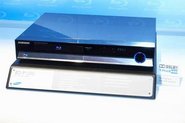High definition movie reader
HD DVD movie players already have competition in the living room: Samsung has just released a $ 1000 BD-P1000, the first movie projector that supports Blu-ray in the market, Sony Pictures and Lions Gate already has. movies in Blu-ray format.
So which type of format is better? At first, we noticed some slight differences in image quality, and you will favor Samsung's Blu-ray reader. However, its price is twice as expensive as Toshiba's HD DVD player.
High definition movies
Comparing Samsung's head with the other two HD DVD models, Toshiba HD-A1 costs $ 499 and the HD-XA1 costs $ 799.
 High definition movie reader Picture 1 Currently, there is no direct comparison between these two formats because no titles have both Blu-ray and HD DVD formats, but both formats share video decoders (MPEG-2, MPEG). -4 AVC and VC1) and the format of the movie disc must not affect the image quality when projecting. Through preliminary testing, each format has a very attractive image, with much more detail and depth than the old format standard in the same title. Readers differ very little in the quality of standard definition movie (SD), and the two Toshiba readers have a bit sharper image.
High definition movie reader Picture 1 Currently, there is no direct comparison between these two formats because no titles have both Blu-ray and HD DVD formats, but both formats share video decoders (MPEG-2, MPEG). -4 AVC and VC1) and the format of the movie disc must not affect the image quality when projecting. Through preliminary testing, each format has a very attractive image, with much more detail and depth than the old format standard in the same title. Readers differ very little in the quality of standard definition movie (SD), and the two Toshiba readers have a bit sharper image.
A little note: although high-definition movies offer much better quality than standard formats, the HD movie itself is not really complete. In Blu-ray movie discs so far, there are some scenes that look more "grainy" than expected; on the contrary, some other titles like Ultra Violet are very sharp and eye-catching. What shows on HD DVD also has many different results, there are also many scenes that are "deformed" than we think.
Such image problems will not go away. There are many different effects affecting high-definition movie quality, including the status of the original movie, video decoding codec, encoding quality, bit-rate when encoding and decoding chip of the head read. Sometimes it is the intention of the director and the filmmaker. In some films, images are made "softer", or "processed" for dark and beads, while others are sharpened and more purposeful. If you are interested in these issues, read the introduction of the HD movie title before buying.
Even if you don't want to compare the rivalry between Blu-ray and HD DVD, these readers have a lot of differences in usage and speed.
Samsung's compact reader has a handy remote control; LCD display easy to monitor; and a 10-in-2 memory card reader for viewing photos and listening to MP3 music. In contrast, both Toshiba models are slightly bulky, the LCD of the reader is raw and there is no memory card reader. Samsung's reader is quieter, although if you watch "Caribbean Pirates" with 5.1 sound system, the sound of the locomotive can not be heard.
In general, Samsung is faster than both Toshiba models in terms of disk reading and response speed (Toshiba's head has not updated the firmware), even re-reading the place where you turned off the computer before. But sometimes Sony Blu-ray discs are a bit slow when accessing chapters, showing a Windows-style "hourglass".
Toshiba's model may be superior to Samsung's in the future. Both Toshiba models have USB and 1 ethernet ports to access advanced interactive features if HD DVD movies are supported and to download firmware updates.
The battle of high definition DVD format is still very long to come and a series of new hardware lists will appear later this year.
However, with the head recorded for the living room, it must not appear until the following year. And both LG Electronics and Samsung are discussing to offer a head that can read both Blu-ray and HD DVD. Recently, Ricoh introduced technology that can read both formats. If you are not eager to watch HD movies, wait until there are more options.
You should read it
- Toshiba Z Series - Ultrabook premium for entrepreneurs
- How to make great movie trailers on iPhone
- Korean movies that cause fever should not be missed
- Toshiba's price range from 12.5 million to Vietnam
- How to Use Windows Movie Maker
- How to Make a Slideshow with Windows Movie Maker
- Additional Toshiba laptops for pupils and students
- Toshiba Chromebook 13.3 inch officially launched
- How to Make a Video in Windows Movie Maker
- Toshiba comes to the new Satellite line for $ 1,600
- How to create movie posters in GIMP
- The easiest way to reset Toshiba Smart TV






 HP released a new multimedia notebook
HP released a new multimedia notebook Harmful myths when adjusting the TV definition
Harmful myths when adjusting the TV definition How to Tell if You're Watching TV in HD
How to Tell if You're Watching TV in HD How to download Realtek High Definition Audio driver for Windows 11
How to download Realtek High Definition Audio driver for Windows 11 5 netbooks have high definition screens
5 netbooks have high definition screens Top 5 best PDF reader apps on Android
Top 5 best PDF reader apps on Android